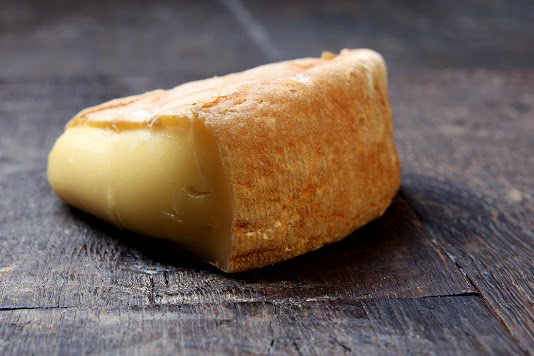The most common question I get asked as a Cheesemonger is “can you eat the rind of this cheese?” The simple answer is…. if your teeth can get through the rind and it tastes nice, eat it!
However, there are a few different types of rind and there are some basic rules we can follow. First of all, in most cases, the rind is simply the skin of the cheese, it is a concentration of the interior paste and is therefore generally harder and drier and has a concentrated flavour. Sometimes that concentrated flavour is pleasant, sometimes it is actually tastier than the paste (and should be eaten together with it) but sometimes it can be bitter or sour, certainly not pleasant to most people. So let’s go through the different styles and I’ll give my personal opinion.
Soft or “Bloom rinded”cheeses like Brie or Camembert. Generally speaking, always eat the rind which is usually the best part! It is soft and can have a texture like cotton wool and can be slightly chewy – wonderful when the cheese is baked! In the middle of the cheese it is softer and milder getting a little tougher and stronger flavoured on the outside. There are other soft cheeses that don’t actually develop a natural rind such as fresh goats cheese with ash coating. Definitely eat this!
Soft “wash rinded” cheeses such as Vacherin Mont d’Or, Epoisse and Stinking Bishop are similar to the above but the cheeses have been washed during maturing with a salty or herby brine or alcohol which creates a reaction with natural bacteria and can make the rind a little sticky and sometimes very smelly and extremely tasty! On the British Stinking Bishop (washed with Pear Cider - Perry) made by Charles Martell in Gloucetershire, the rind towards the centre of the circle is soft and sticky (one side, the bottom side where the cheese has been stored most recently) will be much sticker – I try to turn my Stinkers in stock every 2 days so the 2 sides develop equally. But on the very outside of the cheese the rind can become hard and crunchy and more intense in flavour. This is my favourite part of the cheese!
Soft Blues wrapped in foil such as Yorkshire Blue and Blue Monday (the French Roquefort also comes under this category). The cheese is wrapped in foil before a natural rind has had chance to develop and it hardly develops at all under the foil so can be eaten. Although as the cheese ages a little, the flavour will become stronger towards the edges. Other softer blues such as Gorgonzola do have tasty rinds but generally speaking, with blues, the older and more defined the rind, the less palatable it is.
Naturally rinded Blues such as Blue Stilton, often referred to as “The King of Cheeses” develop a dry slightly tough and bitter rind. This is surprisingly (to most people) edible although as the cheese ages and the rind becomes thick it can become bitter (see below, cooking with rinds). Other similar blues I sell such as Swaledale, Dorset Blue Vinney and Hebridean Blue I also find unpalatable, although Burts Blue from Cheshire and Barkham Blue from Berkshire have very tasty rinds. Again, if in doubt, taste it!
Waxed cheeses are mostly known in the UK and the Netherlands. These of course should be removed but the hard rind under most of the Dutch cheeses is edible.
Herb Rinded Cheeses are not so common but I regularly sell Cornish Yarg which is wrapped in either Nettles or Wild Garlic. These are both safe to eat although I find the Nettle rind a little tough and bitter. The Wild Garlic though is softer and greener and looks really attractive on the cheese board – try roughly chopping the cheese and rind together, some of the leaves will come apart from the cheese making it look almost like a cheese salad!
Hard cheeses. Starting with British, traditional raw milk Cheddars, Red Leicester and Cheshire cheeses are wrapped in cloth which is then smeared with lard (or sometimes butter) to create an air tight seal. This cloth is usually removed by the cheesemonger so you should not have it on your cheese at home. However, there is a natural rind under this cloth and it is edible but sometimes tends to taste a little “farmy” or musty. Other hard cheeses from other countries, such as most Swiss cheese develop very hard rinds which, although safe to eat are usually too hard to get your teeth through. (again, see “cooking with rinds” below).
Cooking with Rinds.
The Italians know how to do this best. The rinds of Parmigiano-Reggiano, or Parmesan as it is often known to English speakers are too hard to eat but are always kept to flavour soups…. you only need to put the rind in the soup for a few minutes near the end to give a gentle flavour enhancement to your Minestrone soup. The rind can be dried and used a few times.
Other hard rinded cheeses such as Gruyere and Emmentaler can be used in similar ways (but beware, some cheaper industrial versions do use a parafin wax on the very outside of the rind which will ruin your soups flavour), Raw milk Cheddar (with the cloth removed), and the rind of Stilton if you don't like it, can be tied up in a muslin bag (as they will fall apart in cooking) to flavour vegetable soups such as Broccoli and Stilton soup, a great British classic. Rinds can also be finely minced and added to minced beef to create the ultimate cheese burger (smelly washed rind and blue rinds are particularly good).
© Michael Jones, January 2018

Comments
Post a Comment